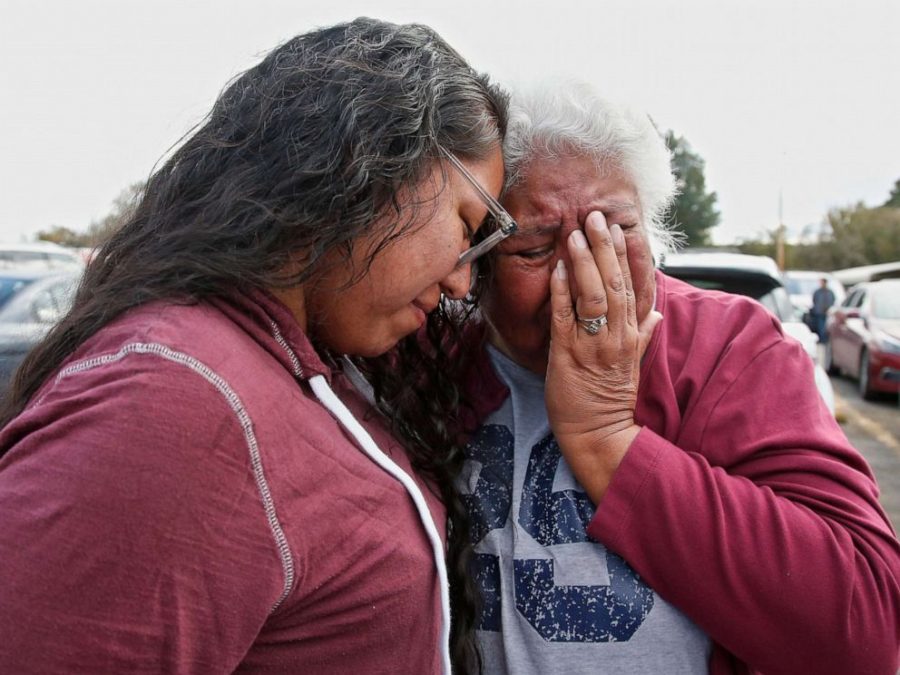Victory for the incarcerated: Oklahoma makes history by freeing hundreds
Photo courtesy of ABC, Sue Ogrocki
After years of heartbreak and emotion, Tess Harjio leaves the Oklahoma Eddie Warrior Correctional Central on November 4, ready to live out her new second chance. She embraces her grandmother Sally Taylor who hugs her with excitement and relief, all while crying tears of joy. This day brings hope for prison inmates, now known as the highest commutation in U.S history. As of now, state officials plan to release hundreds more in the near future, hoping to produce a similar occurrence.
November 11, 2019
As of November 4, the state of Oklahoma released nearly 500 inmates from prison, a result of the recently passed Criminal Justice Reform of 2018. This made history by becoming the highest single-day mass commutation in the United States since former president Barack Obama’s release of 330 federal prison inmates on his last day in office. As these inmates released, new opportunities followed and the anticipated reuniting of family members relinquished heartfelt emotion and relief.
“It’s when Oklahomans care about each other that we roll up our sleeves and we make it happen and give you a second chance,” Oklahoma Governor Kevin Stitt said in an interview with ABC.
Prior to the reform, Oklahomans voted against the harsh punishments of low- level inmates incarcerated in 2016 due to House Bill 1265, a bill providing the possibility of an early release for inmates convicted of drug or property related crimes. Once the reform passed in 2018, Oklahoma state officials agreed that action needed to be taken.
After careful consideration from the Oklahoma Pardon and Parole Board, the group approved the commutations Friday and forwarded them to former mortgage CEO and current state Governor Kevin Stitt. After Stitt announced he agreed with the reform, the news spread to local prisons, soon allowing 462 drug-related convicts to be released.
“This marks an important milestone of Oklahomans wanting to focus the state’s efforts on helping those with nonviolent offenses achieve better outcomes in life’,” Stitt said in an interview with NBC.
Since the state continues to hold the highest incarceration rate in the world, the reform quickly reduced prison populations and slowed growth, relieving citizens of the growing tax percentages and policies that feed the staggering rate.
To better prepare the released for their fresh start, the state held multiple career and housing transition fairs, providing former inmates with job and housing opportunities as well as financial aid. State officials also arranged to secure each inmate a state-issued identification card, crucial for securing jobs, housing, and other essential needs. Now as the hopeful 500 restart their lives, over 900 inmates continue to apply for early release, with a projected 2,000 or more empty Oklahoma prison beds by the end of the year.
Looking at Georgia, in 2012 the state began releasing lesser crime convicted inmates to maintain the state’s incarceration rate. As of 2018, however, their efforts became futile with Georgia hitting a high incarceration rate of 970 inmates per 100,000 people. This amount concerns Georgians, considering the average incarceration rate of the United States hit only 716 per 100,000 as of 2013. Although the circumstances concern fellow Georgians, a similar pardoning occurrence may eventually hit the state in major cities such as Buckhead and Atlanta in years to come, due to an increase in prison populations.
The average Georgian pays a 6 percent tax rate, a reasonable rate in comparison to other coastal states. However, the high incarceration rate causes a number of problems and highlights the disparities that Georgia prisons obtain. In 2018, the incarceration rate of Georgia remained the second-highest in the nation, and up until 2016, the state lived in fear of an enormous 264 million dollars to upkeep state prisons, a nightmare for taxpayers. Although the reform slowed the rate (preventing the extra cost), the population of Georgia state prison remains double the size at 56,000 and growing, high in comparison to 20 years, accompanied by unusually long probation sentences of seven years.
Although Georgia remains high for the average incarceration rate and in poverty-stricken areas experiences a similar opioid and methadone drug crisis of Oklahoma, that carries into Georgia’s culture. This, however, does not necessarily concern Georgia’s republican Governor Kemp.
“The Georgia legislature as of now is dominated by a republican party at present, controlling both the house and the senate in Georgia, so the Governor is also republican. As of now, it seems very unlikely to me that Governor Kemp would take interest in commutating drug charged inmates. He hasn’t indicated that he’s interested in doing so. However with recent settlements in pharmaceutical companies and their role in the drug crisis, the issues regarding fisar and their significant settlement paid towards dealing with the results of the crisis and so that might be something to occur in Georgia, more of an emphasis on financial settlements rather than an eradication,” AP Comparative Government teacher Carolyn Galloway said.
Now as the formerly imprisoned reunite and take back their lives, the victory and privilege of freedom no longer worries them. As the reform continues to provide sympathy for convicts, Oklahoma predicts that by the end of the year prisons will empty 2,000 or more prison beds, planning to realize hundreds more in the near future. Until then the criminal justice reform strikes success, showing that second chances can become a reality.




